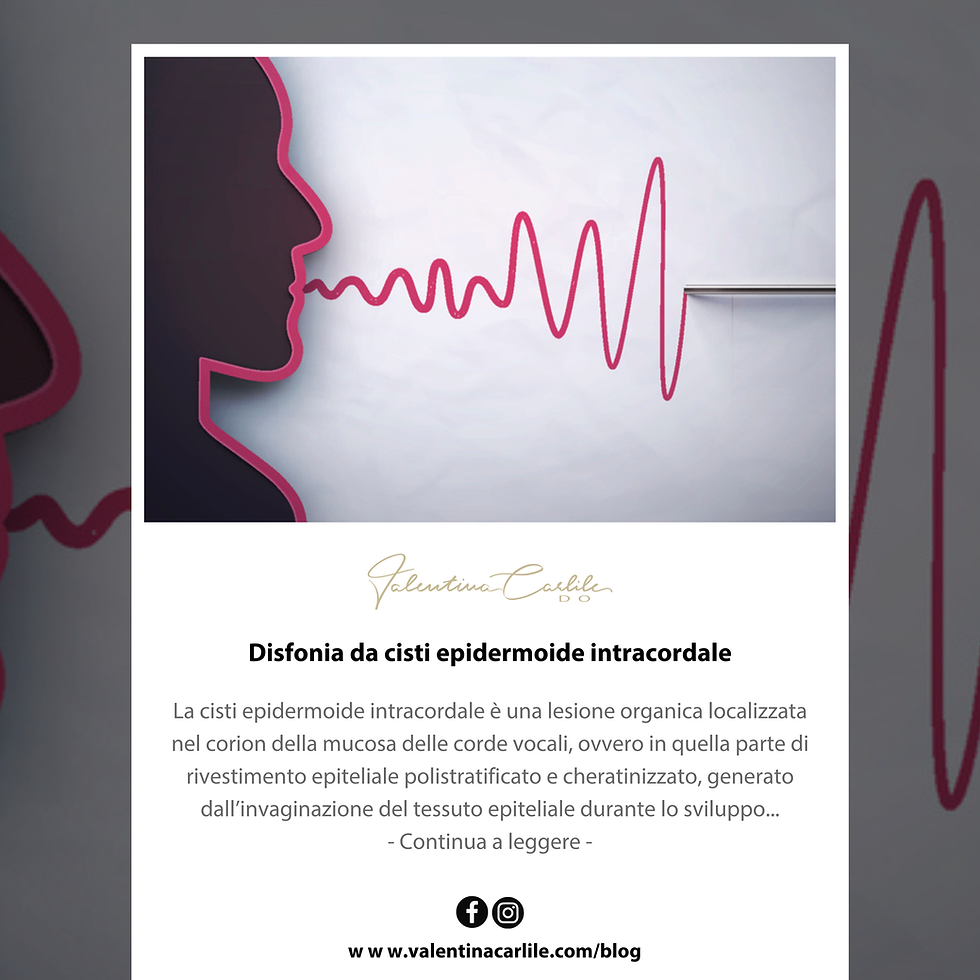Sound Control: Singing vs. Wind Instrument
- Valentina Carlile DO

- Mar 2, 2022
- 4 min read

When you take a rubber band and stretch it, its increased length translates into a reduction in its thickness. The vocal cords or lips can shorten or lengthen, adapting at will to different artistic needs, through the action of the muscles of the larynx and face respectively. This allows you to change tension and thickness. When the vocal cords or lips are not tight and thick, they vibrate at a lower frequency than when they are tight and thin. A low-frequency vibration translates into a low pitch and a high-frequency vibration into a high pitch.
The vocal cords shorten and lengthen substantially modifying the position of the cartilages of the larynx through the action of the muscles in this area.
In the case of the lips, however, the changes are carried out by tensioning the tissues through the action of the facial muscles. Since these muscles are interconnected, it is necessary to activate them in a coordinated way to obtain the correct tension without causing grooves in the lip or changing its configuration, which would change the characteristics of the vibration and therefore the sound.
While the pitch of each note is determined by the speed with which the vocal cords or lips open and close, the intensity of the sound depends on the extent of their movement. When the air outlet pressure is increased, the strings or lips vibrate with greater amplitude and produce a more intense sound. But to overcome the greater tension of the same in high-pitched sounds, it is necessary to also increase the air pressure.
Controlling the sound The sound produced by the vocal cords, the reed or the lips is very complex. To make it pleasant, projected and rich, it is necessary to filter certain frequencies, amplify others and give color to the sound. This is achieved by using resonance chambers. In the case of wind instruments the main resonance chamber is the instrument itself. For the singer, the chambers are the air-filled cavities above the larynx (the top of the larynx, the pharynx, the mouth, and the nose). Depending on the shape, volume and characteristics of each cavity or instrument, the air inside will vibrate at particular frequencies but not others, fulfilling this amplification and filtering role that determines the unique tonal characteristics of each individual or instrument.
Furthermore, it is possible to regulate the sound through the action of the tongue, lips, cheeks, teeth and palate on the same resonance cavities. This allows, for example, to articulate sounds or play staccato notes on wind instruments using the tongue and to reproduce vowels through the correct positioning of the lips and tongue.
In the case of the singer, the sounds produced by the vocal cords have very variable frequencies. To accommodate the full range of sounds produced, it will be very important to be able to quickly change the volume and shape of the resonance cavities. Of all these, the mouth is the most important as it can adapt more easily to the sound produced, thanks to its variable opening, the positioning of the tongue and the role of the lips. Thus, for example, to make a high-pitched sound, it is necessary to increase the opening of the mouth, raise the palate as much as possible and flatten the tongue. This makes the cavity larger so that the low harmonics that accompany the base tone are not lost, producing a high note with a full-bodied, smooth tone. Through the action of its muscles, the pharynx can assume a higher or lower position and therefore increase or decrease its volume and resonance capacity. Furthermore, changes in the larynx or tongue also change the characteristics of the pharynx. Thus, for example, when the larynx descends, the size of the pharyngeal cavity increases with the result that the air resonates in this enlarged cavity acquiring a characteristic tone that we could define as pompous. Finally, there are some fixed resonators whose volume cannot be changed, such as the nose, which is only involved in nasal-type sounds, and the sinuses (small air chambers in the facial bones). Although the sinuses cannot greatly change the sound, they can resonate internally, especially with high notes. This will give information about the quality of the voice, leading to the sensation of the voice being heard in the face mask area.
As for wind players, the column of air inside the instrument vibrates more easily at specific frequencies. By changing the length of the instrument using the valves or holes or by lengthening the slider you can select the correct resonances for the note you want to play. Even the lips or the reed have their own resonant frequency which can be modified by varying the muscle tension. However, the resonances of the instrument are stronger than those of the lips or reed, which means that the instrument controls the vibration range of the lips and reed. This control is not absolute and it is always possible to adjust the pitch of a note by changing the tension. Therefore, a trombonist can play a vibrato by moving the slide slightly, while players of other brass instruments do so by "lipping". In addition to regulating the range of vibrations, the instrument, like the voice, filters certain frequencies, amplifies others and enriches the sound by converting this "humming" noise into a pleasant and powerful sound. The sound waves generated by the reed or the lips spread both towards the instrument tube and towards the buccal cavity (mouth) and the airways. A good part of the energy that moves towards the mouth is lost through absorption by the tissues. However, the resonating chambers (especially the mouth and pharynx) are capable of responding to some frequencies, as occurs with singing. Professional musicians are able to modify these cavities to improve sound quality and stability and to assist in better transition between playback modes.





Comments